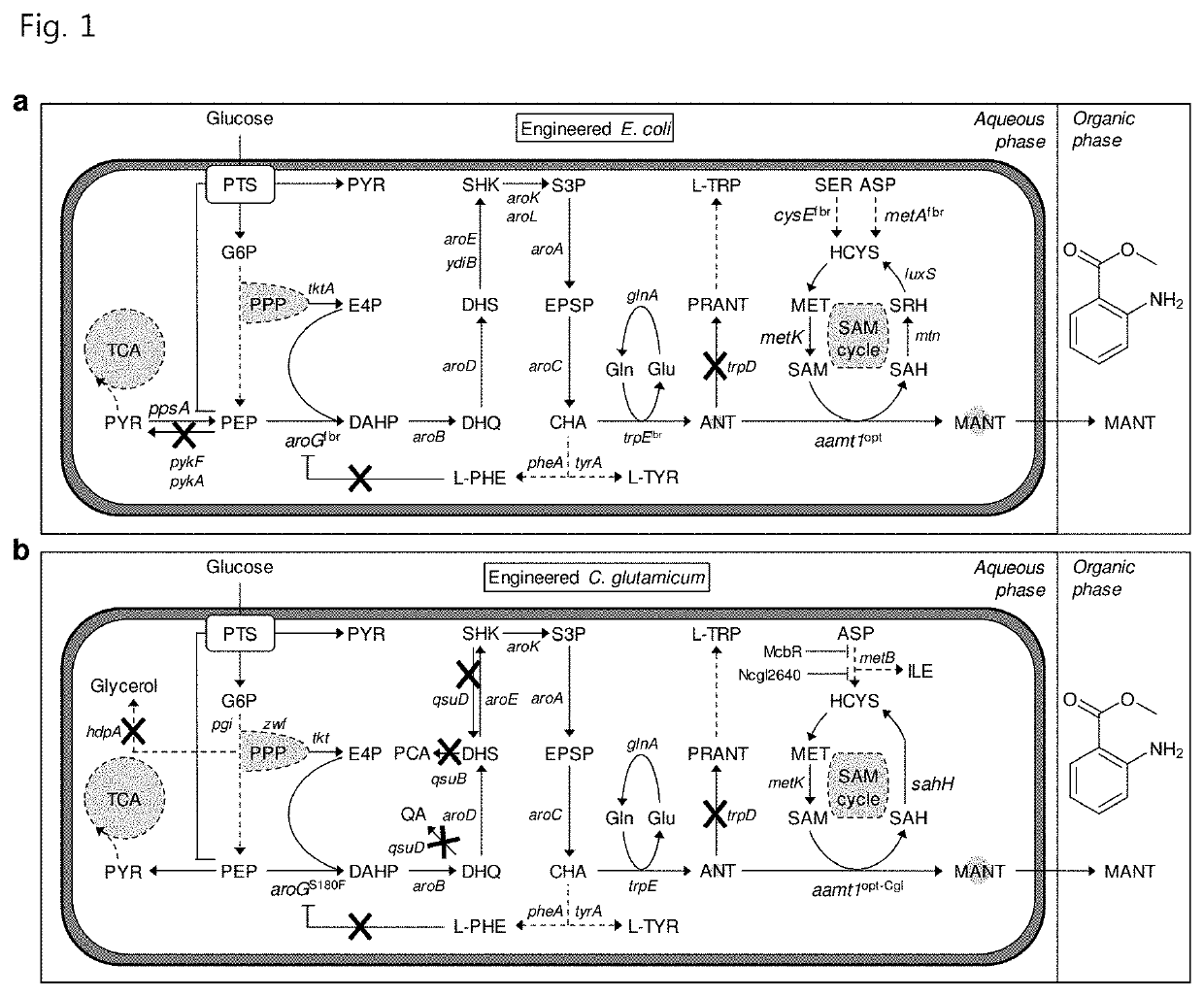Recombinant microorganism capable of producing methyl anthranilate and method of producing methyl anthranilate using the same
a technology of methyl anthranilate and recombinant microorganisms, which is applied in the direction of enzymology, viruses/bacteriophages, transferases, etc., can solve the problems of large quantity of acid catalysts, inability to directly extract mant from plants, and difficulty in achieving high value-added methyl
- Summary
- Abstract
- Description
- Claims
- Application Information
AI Technical Summary
Benefits of technology
Problems solved by technology
Method used
Image
Examples
example 1
Construction of MANT Biosynthesis Pathway
[0083]1-1. Selection of Metabolic Circuit from ANT to MANT
[0084]Research commenced based on mechanisms of MANT biosynthesis in plants due to the lack of sufficient research on MANT metabolism in E. coli and C. glutamicum strains used in the present invention. Two different enzymes, anthraniloyl-CoA:methanol acyltransferase and SAM-dependent methyltransferase, are reported to mediate biosynthesis of MANT from anthranilate in plants (FIG. 3 in part a). Both routes share the same precursor metabolite ANT, which is derived from the L-tryptophan (L-TRP) biosynthesis pathway in plants. The present invention focuses on selection of SAM-dependent methyltransferase encoded by aamt1 rather than anthraniloyl-CoA:methanol acyltransferase in designing metabolic pathways for MANT biosynthesis for the following reasons. First, anthraniloyl-CoA:methanol acyltransferase requires two steps (CoA activation and acyl transfer) for production of MANT from anthrani...
example 2
MANT Toxicity Test on E. Coli and Two-Phase Extraction Flask Culture
[0090]2-1. Test of MANT Toxicity on E. Coli
[0091]Prior to further manipulation for MANT production in ANT-producing strains, a MANT toxicity test was first conducted on E. coli. MANT has low solubility in water (2.85 g / L at 25° C.) and an octanol / water partition coefficient (log Kow) of 1.88. It is known that, as the polarity in E. coli increases, the octanol / water partition coefficient decreases and the toxicity of the solvent increases. Thus, MANT was expected to be toxic to E. coli. As a result of exposing E. coli to various concentrations of MANT up to 1 g / L, the final OD600 value was significantly reduced. The MANT toxicity test on E. coli showed that E. coli can withstand MANT up to 0.5 g / L. The final OD600 value when exposed to 0.5 g / L of MANT was found to be about one third of that of the base strain not exposed to MANT (FIG. 4). The low resistance of E. coli to MANT could adversely affect E. coli mutations...
example 3
Optimization of AAMT1 Expression Level to Improve MANT Production in E. Coli
[0094]The MANT production pathway was constructed in E. coli and optimization of the expression level of AAMT1 was attempted in order to enhance MANT production. In order to obtain AAMT1 at various levels of expression, the aamt1 gene expressing AAMT1 was introduced into two different expression vectors, pTac15K-derived vector (low copy number) and pTrc99A-derived vector (medium copy number). The two vectors each have a series of synthetic promoters with varying transcription intensities (see Table 3, BBa_J23177, BBa_J23114, BBa_J23105, BBa_J23118, BBa_J23101, BBa_J23100).
TABLE 3Sequences and relative intensities of synthetic promotersRelativeNameintensitySequence (5'-3')BBa_J231001 TTGACGGCTAGCTCAGTCCTAGGTACAGTGCTAGCBBa_J231010.70TTTACAGCTAGCTCAGTCCTAGGTATTATGCTAGCBBa_J231180.56TTGACGGCTAGCTCAGTCCTAGGTATTGTGCTAGCBBa_J231050.24TTTACGGCTAGCTCAGTCCTAGGTACTATGCTAGCBBa_J231140.10TTTATGGCTAGCTCAGTCCTAGGTAC...
PUM
| Property | Measurement | Unit |
|---|---|---|
| Electrical resistance | aaaaa | aaaaa |
Abstract
Description
Claims
Application Information
 Login to View More
Login to View More - R&D
- Intellectual Property
- Life Sciences
- Materials
- Tech Scout
- Unparalleled Data Quality
- Higher Quality Content
- 60% Fewer Hallucinations
Browse by: Latest US Patents, China's latest patents, Technical Efficacy Thesaurus, Application Domain, Technology Topic, Popular Technical Reports.
© 2025 PatSnap. All rights reserved.Legal|Privacy policy|Modern Slavery Act Transparency Statement|Sitemap|About US| Contact US: help@patsnap.com



